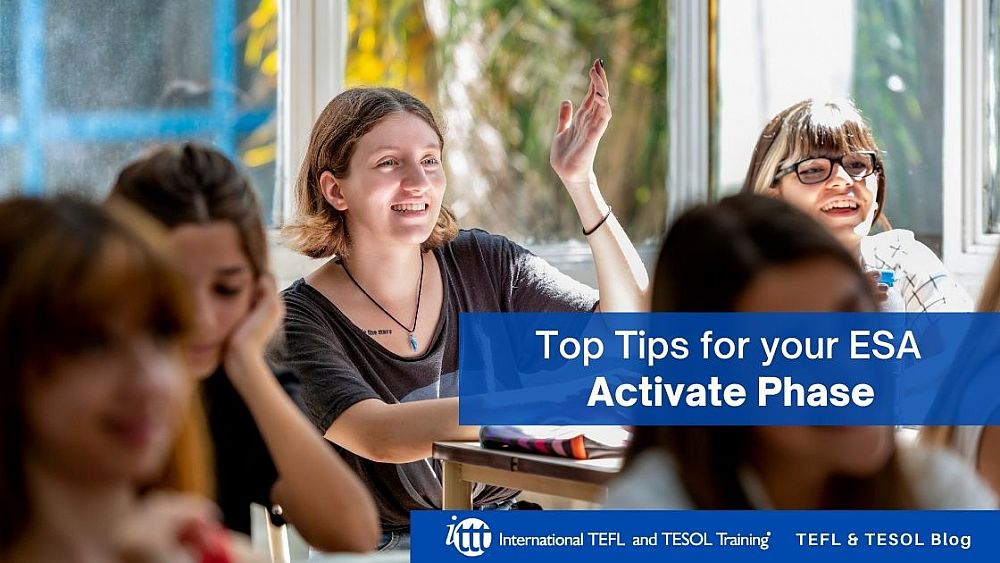Top Tips for your ESA Activate Phase

Regardless of the ESA type applied in a lesson plan(straight-arrow, boomerang, patchwork, and so forth), the activation phase, when the target language is supposed to be practiced and promoted through various techniques and activities, is usually the last stage of every lesson. A well-designed activation can be an essential characteristic of a fruitful lesson which highly affects learners' level of participation during the lesson and their sense of achievement at the end of the lesson. This phase is naturally divided into some steps to facilitate the activation process, including the controlled, semi-controlled, and free practices that are briefly discussed in this post.
Table of Contents
Check out what our course grads say in our many video testimonials!
Controlled practice
Controlled practice, which is the mechanical practice of the new target language, bridges the gap and merges the study phase and the activation. This is usually applied through a worksheet including matching, gap filling, ordering, and activities with only one predictable correct answer possible for each exercise. It also functions as feedback or revision of the study phase and is highly focused on accuracy. Additionally, this step aims to provide the teacher and the learners with a chance to assess and evaluate their acquisition of the target language and spot their misunderstandings or miss interpretations of the topic so that further adequate remedies can be provided. The following can be an example of a gap-filling controlled practice for a lesson aimed at the function of past tense in a context centered on vacation.
A. Complete the sentences with the past simple form of the verbs in brackets. 1. We really (enjoy)......... our vacation last summer.2. James (stop) …….his car at the beach.3. Mark (not swim)......... in the sea. 4. I (buy)........ a new baseball when we(be).....at the beach.5. We (not go) ……..back to the hotel at night.
Semi-controlled practice
Matter-of-factly, a semi-controlled practice, when more than one answer is possible, but it's still limited, works as a link between controlled practice and free practice. The smooth flow deriving from a gradual transition through a controlled practice to a semi-controlled one and finally the free practice may help students manage to take the lesson in and digest the content straightforwardly so as to master various aspects of the target language and examine their ability in terms of language production in sentence level.
B. Unscramble the questions and answer them with your partner. 1. did/you/where/on/last/vacation/go/your/?2. was/the/weather/how?3. did/who/with/go/you?4. you/how long/ stay/did?5. did/you/when/back/come/?
Free practice
In this final stage, learners can make the most of all and any language at their command without being restricted and limited to applying the new target language covered and learned during this specific lesson. Communicating actively with a considerable degree of involvement enables learners to animate their background information and blend it with the new target language in order to reinforce the learning process and language generation beyond the sentence level. The following is a simple example of free practice for the same vocation lesson being discussed.
Provide two sets of cards, one with some virtual characters and a brief description of their likes and dislikes or other personality traits, and another set representing some holiday resorts with different qualities.
Hand out the cards and clarify that the students with resort cards are travel agents and others are travelers looking for an appropriate travel destination.
Instruct the students to stand up, walk around and describe the resorts or their characters and what they need in order to find an appropriate match.
When the matching is done, ask the pairs to sit together and agree on the holiday details, including the accommodation, weather, cost, company, fun activities, the duration, and so on. In the next step, pairs can present the character, and the holiday they worked on to the class.
Post the matched cards on the board or the walls. Use an attractive grouping technique and divide the class into two new groups so as to answer the following questions.
- Who didn't enjoy his/her holiday? Why?
- Who had the best holiday? Why?
- Who had the worst holiday? Why?
- Who had the most expensive holiday? Why?
- Who had the cheapest holiday? Why?
- Which holiday resort do you like the best? Why?
Conclusion
Although students are not directly instructed, the setting pushes them towards practically applying the past simple, which is the target tense of the lesson. Feedback on both task and language is consequently required to close the activities. It is also used to prevent and clear up any possible confusion that might interrupt the flow of speech, and fluency is not highly recommended. Such delayed feedback on language based on errors noted during close and distant monitoring appears more appealing. And finally, the fact that the activate phase is supposed to be the biggest stage of a lesson emphasizes the importance of this step and its profound effects on the learning process.
Apply now & get certified to teach english abroad!
Speak with an ITTT advisor today to put together your personal plan for teaching English abroad!
Send us an email or call us toll-free at 1-800-490-0531 to speak with an ITTT advisor today.
Related Articles:
- Top 10 Cities in Europe with the Highest Demand for English Language Teachers
- 5 Reasons To Take A TEFL Course Right Now - Even If You Are Not Leaving Yet | ITTT | TEFL Blog
- All the Documents You Will Need to Teach English Abroad
- The Impact of Positive Motivation on an ESL Classroom
- You're Never Too Old to Change Your Life and Do a TEFL Course | ITTT | TEFL Blog
- Getting Student Placement Right - The Best Desk Arrangements for EFL Students



